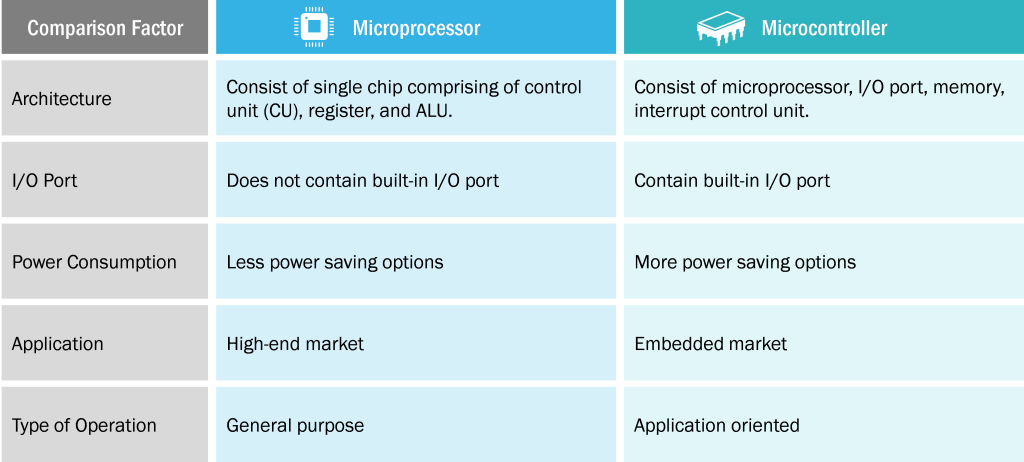Embedded computing is part of a computer system designed for specific functions. It functions like a general-purpose computer which is designed to perform a wide range of processing task. Embedded computing is managed by single or multiple processing devices such as a microcontroller, microprocessor, digital signal processors (DSPs), application-specific integrated circuits (ASIC), field-programmable gate array (FPGA), and others. These processors are integrated with the system to handle mechanical or electrical interface.
The growing adoption of IoT application in diverse industries is one of the crucial factors influencing the embedded computing demand. Additionally, the increased need for superior performance, secure connectivity, lower cost, power efficiency, and faster time to market are other significant factors bolstering the demand for embedded computing. Smaller and energy-efficient semiconductors are now available in the market owing to advancements in the design of semiconductor. It has further enabled design engineers to enhance security and system intelligence across a wide range of products. Embedded systems are well-matched to fulfill the demand for such products.
Embedded Computing: Overview
The embedded computing devices are a combination of computer hardware and software designed to access, store, process, and control the data from various electronic devices, along with performing similar other tasks. An embedded computing system is designed for a specific function or a set of the system such as automobiles, agriculture and process industry devices, industrial machines, cameras, medical equipment, aircraft, household appliances, and others.
Embedded computing devices vary from the devices having no user interface (UI) to the devices with sophisticated graphical user interface (GUI). The devices with no UI are typically designed to perform a single task, while the GUI devices, such as mobile devices, can be multitasking. The embedded computing is classified on the basis of the component into microprocessors, microcontrollers, application-specific integrated circuits (ASICs), digital signal processors, field-programmable gate arrays (FPGAs), memory, software, and others.
According to The Insight Partners Embedded computing market on a global scenario was valued at US$ 32.1 Bn in 2018 and is expected to grow at a CAGR of 8.7% during the forecast period 2019 – 2027, to reach US$ 67.3 Bn by 2027.

Microprocessor:
Microprocessors are the devices fabricated on a small chip, capable of controlling microcomputers, performing arithmetic logical unit (ALU) operations, and facilitating communication with other devices connected to it. These are compact, low power-consuming, cost-effective, versatile, and reliable devices. Also known as microcomputers, these mass storage devices are the advanced form of computers. It has wide applications in communication systems, accounting systems, game consoles, and military applications, among others.
The microprocessor industry is dominated by the two major competitors—Advanced Micro Devices (AMD) and Intel. At present, Intel is the market leader in the microprocessor market, with more than 70% of the market share. 80×86 (Intel), 68HCxx (Motorola), SPARC (Sun), and ARM (ARM) are the different streams of microprocessors used in embedded computing devices. The increasing application in space, telecommunications, robotics, transportation, home appliances, and others is expected to create significant demand for microprocessor.
Microcontroller:
Microcontrollers are low-cost, compact, and self-contained computer-on-a-chip systems used in the embedded systems. These are battery-powered devices having low power requirements. Microcontrollers are widely used in computer peripherals, consumer electronics, car engines, and test and measurement equipment. Based on bits, they are classified as 8-bit, 16-bit, and 32-bit microcontrollers. The example of the 8-bit microcontroller is PIC1x, Intel 8031/8051, and Motorola MC68HC11 families. Intel 8096, PIC2x, and Motorola MC68HC12 families are the examples of the 16-bit microcontrollers. Intel/Atmel 251 family is one of the examples of the 32-bit microprocessors, and these devices are used in medical devices, office machines, and other types of embedded systems.
The growing consumption of consumer electronics, alongside the demand for higher performance and greater functionalities, is creating a significant demand for microcontrollers. The increasing focus on the implementation of energy-efficient devices in both process and discrete industries is expected to create a significant demand for microcontrollers.
Microprocessor vs. Microcontroller

Digital Signal
Processors (DSPs)
Digital signal processors are the highly specialized microprocessors primly designed for processing digital signals, among many other mathematical functions. These processors are witnessing high demand since the past few years due to their wide application in various devices, ranging from advanced scientific instruments to cell phones. These signal processors have major applications in digital sound and image processing, consumer electronics, digital communications, industrial and automation electronics, medical electronics, and others. Motorola, Texas Instruments, Analog Devices, and Lucent Technologies are the key digital signal processor providers.
The increasing demand for low-cost consumer products such as multimedia computers, cellular telephones, and high-fidelity music reproduction is expected to create a significant demand for digital signal processors in the coming years.
Application-Specific Integrated Circuits (ASICS)
An ASIC is a chip designed for specific applications, including transmission protocol or a handheld computer. ASICs are used in a wide application, including environmental monitoring, emission control, and personal digital assistants (PDAs). ASIC is commercially available in 3 categories: full-custom, semi-custom, and platform ASICs.
Due to their high unit costs, ASICs are more commonly used in high-volume production processes. ASICs are thus widely used in smartphones and other consumer electronics that are produced in large batches. It enables a large amount of circuitry incorporated on a single chip. ASIC is highly used in hardware mining devices for crypto currencies.
Field-Programmable Gate Array (FPGAs)
Field-programmable gate array (FPGAs) are semiconductor devices that consist of a matrix of configurable logic blocks (CLBs) connected via programmable interconnects. FPGAs can be reprogrammed to the required functionality or application after manufacturing. Therefore, they are widely used in various industrial applications, including automotive, aerospace & defense, consumer electronics, data centers, wired and wireless communications, medical devices, and image processing.
The telecommunications sector is presenting a high demand for FPGAs due to the increasing use of these devices in telecom and networking systems. Since the past few years, the FPGA in telecom and networking systems has extended beyond bridging logic between components on IC boards as they have pushed to advanced technology nodes of 40–20 nm, 65 nm, and 14 nm. The automotive, telecommunications, and consumer electronics industries are expected to be the key contributors to the demand for FPGA.
Memory
Memory is one of the key components of embedded systems. The performance and cost of any embedded system depend on the type of memory used. Volatile and non-volatile are the common types of memory used in the embedded systems. Volatile memory systems are the type of storage devices that hold the data until power is supplied to it; the systems lose data when the power source is disconnected. Non-volatile memory is the permanent storage devices that do not lose the data when the power supply is interrupted. Random-access memory (RAM) is the most common example of volatile memory, while read-only memory (ROM) is the most common example of non-volatile memory. Flash memory is the type of ROM which is widely used in computation and electronic devices. It is a type of special memory that can be re-programmed with a block of data.
Software
The software used in embedded systems is a set of instructions, which is termed as a program. The embedded devices are programmed to perform a specific task by following the set of instruction, i.e., code. The codes are written to execute a certain function. The common programming languages used are C, C++, Embedded C, and others. It is generally a high-level setup and is compiled down to offer code that can be stuck within the non-volatile memory in the hardware. The complexity of embedded software varies based on the devices they are controlling and application or function of these devices.
Others
The other components include I/O port, timer, communication port, and power supply. The power supply is considered to be one of the key components of embedded computing devices. Mostly, the embedded systems need the power supply of 5 V or lower supply levels, such as 3.3 V or 1.8 V. Proper noise filtering, decoupling, loan and line regulation, efficiency, stable and smooth output, and others are the ideal characteristics of power supply. Timer counters are used to make a square pulse for delays in output. For instance, for the blinking of LEDs, timer counters are used. Embedded computing devices have different types of computing ports for communications; a few of the commonly used communicating ports are Ethernet, UART, SPI, and CAN. I/O ports are used to interact with the embedded devices. For instance, the 8051 microcontrollers feature P0, P1, P2, and P3 I/O ports; and the ATmega series microcontrollers feature A, PB, PC, and PD I/O ports.
Application of Embedded Computing in Various Industry
Embedded system is the core of an automobile’s electronic system owing to its flexibility and versatility. The transformation of electronics has manipulated in automotive design, which includes the power train crash protection, fuel combustion, etc. Innovative use of the embedded system in an automobile can facilitate in controlling the pollution, rising the ability to offer systems monitoring features that are demanded by customers.
At present, a usual vehicle encompasses about 25 to 35 microcontrollers, and certain luxury vehicles comprise of around 60 to 70 microcontrollers per vehicle. Also, a computer-controlled embedded system can be easily found in any typical vehicle on the road. Some of the common embedded systems include anti-lock braking system, airbags, adaptive cruise control, black box, drive by wire, traction control, emission control, telematics, satellite radio, in-vehicle entertainment system, automatic parking, heads up display, night vision, navigational systems, back up collision sensors, climate control, and tire pressure monitor, among others.
Industrial embedded systems find applications in diverse industries to manage and control precise operations in a larger electrical or mechanical system. From HVAC units to complex production lines, industrial embedded systems are pervasive. Industrial embedded systems, in larger systems, function as a programmable operating system that executes specific tasks, including driving motors, networking equipment, controlling assembly line speeds, and adjusting temperatures, among others. Applications of industrial embedded systems also include machine control and machine monitoring, among others.
The communication sector is highly reliable on embedded computing owing to increasing population and evolution of IoT. Embedded computing is used as a sender or receiver for the transmitted signal or data through the Internet or wired connection. Such systems are mobile phones, personal computer, laptops, satellite, radio, Radar, GPS, and others.
Range of embedded systems is available for the network connectivity frameworks such as distributed embedded systems (DES), ubiquitous systems, networked embedded systems (NES), mobile ad-hoc networks (MANET), wireless sensor networks (WSN), and opportunistic networks.
Modern healthcare devices are highly technical and compact, which requires embedded systems. In the healthcare industry, embedded systems are used in the imaging system (PET, CT, and MRI), amplification of sounds in electronic stethoscopes, glucose monitors, CPAP machines, pacemakers, and a range of biomedical sensors. Also, the rising adoption of portable remote monitoring equipment is expected to propel the demand for embedded systems. In the aerospace industry, embedded systems are used for temperature control, sensors, speed control, flight data recorders, flight management systems, and engine control, among others.
Conclusion:
The emergence of connected cars, increasing adoption of advanced electronics in the vehicles, and rising implementation of robotics in automotive manufacturing are the factors boosting the embedded computing growth. Further, the consumer electronics segment is also a noticing high demand for embedded computing. The rising demand for smart consumer appliances is driving the embedded computing demand. Also, the rising adoption of home automation is influencing demand growth.
Key application areas in the consumer electronics segment include smart mobile devices, consumer wearable, gaming consoles, and human to machine interface, among others. In the networking segment, the growth is influenced by rising data traffic demand for wireless infrastructure, electronic equipment, and networking. The robust demand for digital content, security, ubiquitous access, and increased adoption of video communications by enterprises are other factors propelling the embedded computing demand.





